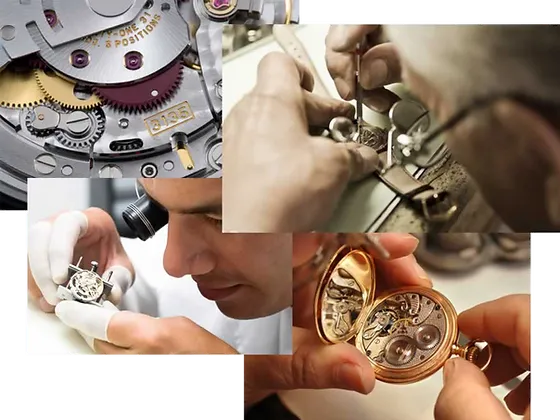Expert Tips – How To Ensure Successful Watch Repairs

Tips for ensuring successful watch repair start with understanding how to handle your timepiece correctly. Whether your watch requires a simple battery replacement or more extensive repairs, knowing what to look for and how to choose a skilled technician can make all the difference. By following these expert suggestions, you can maintain your watch in optimal condition and prolong its lifespan, ensuring that it remains both functional and stylish. Dive into this guide to discover crucial strategies for safeguarding your beloved timepiece.
Types of Watch Repairs
While understanding the various types of watch repairs is vital for ensuring your timepiece functions perfectly, knowing what type of repair you need is equally important. Here are some common repairs you might encounter:
- Battery Replacement
- Mechanical Movement Repair
- Crystal Replacement
- Strap or Bracelet Repair
- Water Resistance Maintenance
After identifying the type of repair, you can take appropriate steps to ensure your watch is restored to optimal condition.
| Repair Type | Description |
|---|---|
| Battery Replacement | Swapping the old battery for a new one to restore power. |
| Mechanical Movement Repair | Fixing the internal mechanisms for accurate timekeeping. |
| Crystal Replacement | Replacing the glass to ensure visibility and protection. |
| Strap or Bracelet Repair | Fixing or replacing a damaged strap for comfort and style. |
| Water Resistance Maintenance | Ensuring seals and gaskets are intact for water protection. |
Mechanical Repairs
Little adjustments in a mechanical watch can have a significant impact on its performance. Whether it’s fixing the movement or replacing worn gears, skilled technicians can diagnose and resolve issues that affect timekeeping accuracy. Proper mechanical repairs require expertise and attention to detail to ensure your watch continues to function as intended.
Quartz Repairs
Any quartz watch repair typically involves battery replacements and movement servicing. These watches are known for their accuracy but can run into issues that hinder performance. Over time, dirt or moisture may affect the internal components, necessitating a thorough inspection and servicing to keep your watch ticking smoothly.
Repairs for quartz watches are generally straightforward but require precision. If the battery is dead, replacing it can often restore functionality. However, if you notice persistent issues like erratic timekeeping, more extensive repairs might be needed to clean or replace internal parts, ensuring longevity and reliability in your timepiece.
Water Resistance Repairs
Watch water resistance repairs focus on replacing damaged seals and ensuring gaskets are intact. Over time, exposure to moisture can weaken these components, leading to potential water damage. Regular maintenance is vital, especially if you frequently use your watch in wet conditions or at significant depths.
Another key aspect of water resistance repairs involves pressure testing after the seals are replaced. This process ensures your watch can withstand the depths specified by the manufacturer. Addressing these repairs promptly can greatly extend the life of your watch and protect it from costly damage.
Essential Tips for Successful Repairs
Some key strategies can greatly enhance the likelihood of a successful watch repair. Consider the following important tips:
- Research repair options thoroughly.
- Ask for recommendations from trusted sources.
- Inquire about the repair warranty.
- Keep your repair expectations realistic.
The right approach will ensure your timepiece receives the best possible care.
Choosing the Right Repair Service
Choosing a reputable and experienced repair service is vital for maintaining your watch’s integrity. Look for technicians who specialize in your watch brand, as their expertise can significantly impact the quality of the repair. Online reviews and testimonials can provide insight into the service’s reliability and professionalism, helping you make an informed decision.
Communicating Repair Needs Clearly
Now that you have selected a service, it is important to communicate your repair needs clearly. Clearly describing the issues with your watch ensures that the technician understands what to address during the repair.
Repair technicians can only work with the information you provide, so be specific about any problems you’ve noticed. Detail the symptoms, such as inconsistent timekeeping or a malfunctioning feature. Providing background information, like previous repairs or part replacements, will also help the technician diagnose the issue more accurately, leading to a more efficient and successful repair process.
Step-by-Step Guide to Watch Repair Process
Once again, ensuring a successful watch repair involves a systematic approach. Following is a detailed breakdown of the important steps:
| Step | Description |
|---|---|
| 1. Diagnosing the Problem | Identify the issue affecting your watch’s functionality. |
| 2. Executing the Repair | Carry out the necessary fixes based on your diagnosis. |
| 3. Testing for Accuracy | Ensure is keeps the correct time post-repair. |
Diagnosing the Problem
To begin, assess your watch to understand the specific issues affecting its performance. Look for obvious signs such as a stopped movement, water damage, or malfunctioning hands. Take note of any irregularities like unusual sounds or erratic time-keeping, as these can help you pinpoint the problem. A thorough diagnosis sets the stage for a successful repair.
Executing the Repair
With your assessment in hand, it’s time to perform the necessary repairs. Depending on the diagnosis, this may involve replacing batteries, re-sealing cases, or fixing movement mechanisms. Engage in careful disassembly to avoid damaging delicate components, and use the right tools to replace or fix parts efficiently.
Watch repairs can vary in complexity, so patience and precision are key. Ensure that you have all required parts and tools ready before you begin. If you encounter unexpected challenges during the repair process, take a moment to reassess your previous steps and gather additional information if needed.
Testing for Accuracy
You should conduct thorough testing to confirm that your watch is functioning accurately after repairs. Set the watch to the correct time and monitor its performance over several days to ensure it keeps consistent time. Time-tracking apps or devices can assist in this process, helping you verify that it maintains standard time-keeping reliability.
Step-by-Step testing allows you to observe any anomalies and make further adjustments if necessary. Look for fluctuations in time-keeping and ensure the watch operates as intended. This final verification phase is important for guaranteeing that your hard work in repairing the watch has been effective.
Factors Influencing Repair Success
Your watch repair’s success hinges on several key factors that can significantly impact the outcome. To enhance the likelihood of a successful repair, consider these elements:
- Quality of parts used
- Experience of the technician
- Type of watch and complexity of the issue
- Environmental factors during the repair
Thou should keep these factors in mind when seeking watch repair services.
Quality of Parts Used
Even the finest technician can only achieve so much with subpar components. High-quality parts are important for long-lasting repairs and ensuring your watch continues to function correctly. Investing in authentic or high-grade aftermarket parts can make a world of difference in the longevity and performance of your timepiece.
Experience of the Technician
Clearly, the technician’s experience plays a significant role in the success of your watch repair. A skilled professional will have encountered various issues and will know how to address them promptly and effectively. Their familiarity with specific watch brands and models also contributes to their ability to diagnose and repair accurately.
Influencing the outcome of your watch repair, a technician’s experience encompasses not just years in the field but also ongoing education in the latest technology and methodologies. A seasoned technician can easily identify subtle issues that less experienced professionals might overlook, reducing the risk of future malfunctions. They also have access to better tools and resources, allowing for more precise repairs. Prioritizing a skilled technician when seeking repair services can lead to a far more satisfying outcome for your cherished timepiece.
Pros and Cons of DIY Watch Repairs
After weighing your options, considering DIY watch repairs can be both empowering and risky. Below is a table outlining the pros and cons of taking the DIY approach:
| Pros | Cons |
| Cost-effectiveness | Risk of further damage |
| Personal satisfaction | Need for special tools |
| Flexible repair time | Limited expertise |
| Opportunity to learn | Potential for voiding warranties |
| Convenience | Complicated repairs may require professionals |
Advantages of DIY Approach
Advantages of taking the DIY approach to watch repairs include saving money on repair costs and the satisfaction of completing repairs yourself. You can work on your watch at your convenience, allowing for a flexible schedule. Additionally, tackling repairs can provide a valuable learning experience, improving your skills and knowledge of watchmaking.
Potential Risks and Challenges
For those considering DIY repairs, there are notable risks and challenges. As you work on your watch, there is a chance of further damaging delicate components, which might lead to more costly repairs down the line. Additionally, you might find yourself lacking the specialized tools or knowledge needed for successful repairs.
Potential mistakes during DIY repairs can sometimes result in irreversible damage to your watch. If you inadvertently void the warranty by opening the watch case, you may miss out on professional service options. The lack of experience can lead to frustration and subpar results, requiring you to seek professional help anyway. Carefully consider your skill level and the intricacies of your watch before attempting repairs on your own.
Maintenance Tips for Longevity
Unlike other accessories, watches require specific care to ensure they last for years. To help maintain the integrity of your timepiece, consider these tips:
- Keep your watch clean and dry.
- Avoid exposing it to extreme temperatures.
- Store it in a protective case when not in use.
- Ensure the crown is fully pushed in or screwed down.
Any neglect in these areas can lead to premature wear and potential damage.
Regular Servicing
While you may think your watch only needs attention when it stops working, routine servicing is vital for its longevity. Aim for a professional check-up every three to five years, depending on the brand and model.
Care and Handling
If you want to extend the life of your watch, handling it with care is important. Avoid excessive force when operating the crown or buttons to prevent potential damage.
Tips for proper care include gently wiping your watch with a soft cloth after wearing it to remove dirt and oils. Avoid wearing your watch while engaging in activities that could cause damage, like swimming in rough water or playing contact sports. Being mindful of where and how you wear your watch is key to maintaining its functionality and appearance.
Summing up
Summing up, ensuring successful watch repairs hinges on your attention to detail and informed choices. Always seek qualified watchmakers who have the right skills and experience for your specific watch type. Use quality replacement parts to uphold the integrity of your timepiece. Regular maintenance checks can prevent larger issues down the line. Proper care and timely attention will extend the life of your watch, keeping it in optimal working condition. By following these expert tips, you can enhance your watch repair experience, ensuring your treasured timepiece receives the best care possible.
Q: What are the key signs that my watch needs repair?
A: There are several indicators that your watch may require repair. If you notice that your watch has stopped ticking or is consistently losing or gaining time, it could have movement issues. Additionally, if the crown feels loose or if there are visible cracks in the crystal or watch face, these can signal that your watch needs professional attention. Water damage is another concern; if you see condensation or moisture under the glass, it’s vital to seek a repair service promptly.
Q: How can I find a reputable watch repair service?
A: To locate a trustworthy watch repair service, start by seeking recommendations from friends or family who have had positive experiences. Research online for local watchmakers and read customer reviews to gauge their reputation. Checking their qualifications and certifications can provide additional confidence in their skills. It’s also beneficial to visit the shop in person; a clean, organized workspace and the repair technician’s willingness to answer questions can be indicators of their professionalism.
Q: What preventative measures can I take to extend the life of my watch?
A: There are several practices you can adopt to prolong the life of your watch. Regularly servicing your watch, ideally once every few years, will ensure that any wear and tear are addressed before they become major issues. Storing your watch in a safe, dry place away from extreme temperatures can also help maintain its performance. Additionally, avoiding exposure to magnets or harsh chemicals and being cautious during activities like swimming can prevent damage. Small habits, like winding your watch appropriately and keeping it clean, can make a significant difference in its longevity.










